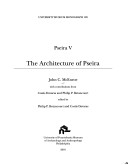Pseira, a tiny islet near the coast of eastern Crete, has been called a priceless jewel in Crete's archaeological crown. In 1906 and 1907, the American archaeologist Richard Seager unearthed the extensive remains of a Bronze Age village on Pseira. Little was known about this site until a joint Greek-American project directed by Philip P. Betancourt and Costis Davaras returned to the island in 1985, after initial efforts by Davaras in 1970.
In this volume the project architect, John C. McEnroe, presents the first thorough analysis of the architecture of this important village. In addition to providing new information concerning building materials and techniques, the layout of domestic architecture, and the organization of Minoan villages, this volume unravels the complex history of architecture at the site. By correlating archaeological stratigraphy, building sequences, and dates provided by ceramic evidence, McEnroe demonstrates that the Late Bronze Age town evolved through a series of three main phases. An extensive series of plans and photographs presents a complete visual record and will form the basis for all future studies of the site.
Along with nearby Gournia, Pseira is the most extensively excavated Minoan village remaining today. This volume will be of interest to archaeologists and to those concerned with the history of vernacular architecture and the history of Crete.
- ISBN10 0924171863
- ISBN13 9780924171864
- Publish Date 29 August 2001
- Publish Status Out of Print
- Out of Print 16 January 2017
- Publish Country US
- Publisher University of Pennsylvania Press
- Imprint University of Pennsylvania Museum of Archaeology & Anthropology
- Format Hardcover
- Pages 139
- Language English
